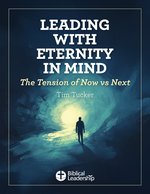Roller coaster of change

Have you ever ridden Disney’s iconic Space Mountain roller coaster? If so, you know that other roller coasters have more thrill features—bigger drops, loops, etc. But that doesn’t mean Space Mountain lacks intensity. What makes it unique is that the entire ride is in the dark. The inability to see what’s ahead dramatically raises the white-knuckle effect.
Roller coasters are designed to increase a rider’s heart rate. However, creating that kind of anxious response shouldn’t be the goal when leading a major change in a church or ministry. Whenever anxiety is high, resistance to the change will rise and buy-in will diminish.
I’m not suggesting that it’s possible to lead change without creating some anxiety. But I am saying that keeping people in the dark creates unnecessary anxiety. Far too often, change efforts are doomed from the start because people are uninformed or confused.
This knowledge gap is often created unintentionally. A great deal of time may be spent deciding what changes to make, with little thought given to how the changes will be communicated. Or leaders may think, Everyone knows why we need to change, when in fact they don’t. Sometimes people are kept in the dark intentionally because “telling them will just invite opposition.”
Either way, it’s better to shed plenty of light on planned changes. Here are three ways to do so.
1. Start with why.
It’s not enough to describe what changes are being proposed. People need to understand why. Without this understanding, they’ll feel like the child whose parent says, “Because I said so.” (See Simon Sinek’s outstanding TED talk on “start with why.”)
2. Create a robust communication plan.
Don’t leave communication about major changes to chance. Anticipate the questions and objections that are likely to arise. Take the perspective of someone who has not been in the loop. Ask for help from people who are gifted in this arena.
3. Connect with head and heart.
The best communication for change efforts is both rational and emotional. That’s because some people respond better to numbers and logic and others to anecdotes and stories. Don’t neglect either.
Space Mountain was designed to keep people in the dark. As you develop plans for a new season, don’t let the same be true in your organization, church or ministry.
Photo source: istock
Mike Bonem is an author, consultant, speaker, church leader, businessperson, husband and father. He has an MBA from Harvard Business School and a breadth of experience in ministry and business, including 11 years as an executive pastor, consulting with Fortune 100 companies, and leading a start-up business. This article was first published on MikeBonem.com. Used with permission. Learn More » |
More on Innovation and Change
- The overlooked risk in non-denominational growth (by Bob Whitesel)
- What can Christian leaders learn from a 20-something YouTuber? Quite a lot… (by Zac McGowen)
- 4 ways to successfully navigate change (by Charles Stone)
- Keys to business partnership success: strategies for long-term collaboration (by Christian Muntean)


